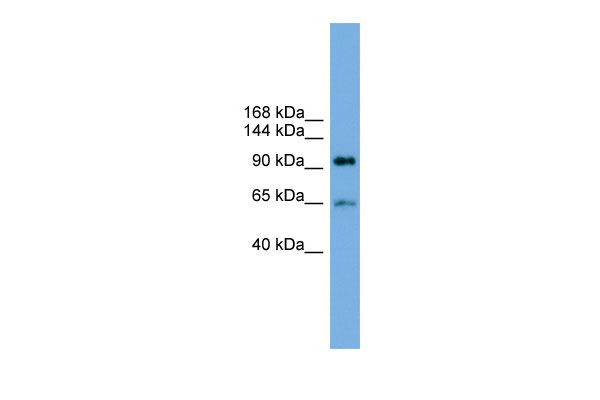EXOC6 antibody - middle region
Rabbit Polyclonal Antibody
- SPECIFICATION
- CITATIONS
- PROTOCOLS
- BACKGROUND

Application
| WB |
|---|---|
| Primary Accession | Q8TAG9 |
| Other Accession | NM_019053, NP_061926 |
| Reactivity | Human, Mouse, Rat, Rabbit, Pig, Horse, Bovine, Guinea Pig, Dog |
| Predicted | Human, Mouse, Rat, Rabbit, Pig, Chicken, Horse, Bovine, Guinea Pig, Dog |
| Host | Rabbit |
| Clonality | Polyclonal |
| Calculated MW | 94kDa |
| Gene ID | 54536 |
|---|---|
| Alias Symbol | DKFZp761I2124, EXOC6A, FLJ1125, FLJ11251, MGC33397, SEC15L, SEC15L1, SEC15L3, Sec15p, SEC15 |
| Other Names | Exocyst complex component 6, Exocyst complex component Sec15A, SEC15-like protein 1, EXOC6, SEC15A, SEC15L, SEC15L1 |
| Format | Liquid. Purified antibody supplied in 1x PBS buffer with 0.09% (w/v) sodium azide and 2% sucrose. |
| Reconstitution & Storage | Add 50 ul of distilled water. Final anti-EXOC6 antibody concentration is 1 mg/ml in PBS buffer with 2% sucrose. For longer periods of storage, store at 20°C. Avoid repeat freeze-thaw cycles. |
| Precautions | EXOC6 antibody - middle region is for research use only and not for use in diagnostic or therapeutic procedures. |
| Name | EXOC6 |
|---|---|
| Synonyms | SEC15A, SEC15L, SEC15L1 |
| Function | Component of the exocyst complex involved in the docking of exocytic vesicles with fusion sites on the plasma membrane. Together with RAB11A, RAB3IP, RAB8A, PARD3, PRKCI, ANXA2, CDC42 and DNMBP promotes transcytosis of PODXL to the apical membrane initiation sites (AMIS), apical surface formation and lumenogenesis (By similarity). |
| Cellular Location | Cytoplasm {ECO:0000250|UniProtKB:O54923}. Cytoplasm, perinuclear region {ECO:0000250|UniProtKB:O54923}. Cell projection, growth cone {ECO:0000250|UniProtKB:O54923}. Midbody, Midbody ring. Note=Perinuclear in undifferentiated cells. Redistributes to growing neurites and growth cones during neuronal differentiation. Colocalizes with CNTRL/centriolin at the midbody ring (PubMed:16213214) {ECO:0000250|UniProtKB:O54923, ECO:0000269|PubMed:16213214} |

Thousands of laboratories across the world have published research that depended on the performance of antibodies from Abcepta to advance their research. Check out links to articles that cite our products in major peer-reviewed journals, organized by research category.
info@abcepta.com, and receive a free "I Love Antibodies" mug.
Provided below are standard protocols that you may find useful for product applications.
References
Deloukas P.,et al.Nature 429:375-381(2004).
Mural R.J.,et al.Submitted (SEP-2005) to the EMBL/GenBank/DDBJ databases.
Li C.,et al.Submitted (DEC-1999) to the EMBL/GenBank/DDBJ databases.
Gromley A.,et al.Cell 123:75-87(2005).
Burkard T.R.,et al.BMC Syst. Biol. 5:17-17(2011).
If you have used an Abcepta product and would like to share how it has performed, please click on the "Submit Review" button and provide the requested information. Our staff will examine and post your review and contact you if needed.
If you have any additional inquiries please email technical services at tech@abcepta.com.













 Foundational characteristics of cancer include proliferation, angiogenesis, migration, evasion of apoptosis, and cellular immortality. Find key markers for these cellular processes and antibodies to detect them.
Foundational characteristics of cancer include proliferation, angiogenesis, migration, evasion of apoptosis, and cellular immortality. Find key markers for these cellular processes and antibodies to detect them. The SUMOplot™ Analysis Program predicts and scores sumoylation sites in your protein. SUMOylation is a post-translational modification involved in various cellular processes, such as nuclear-cytosolic transport, transcriptional regulation, apoptosis, protein stability, response to stress, and progression through the cell cycle.
The SUMOplot™ Analysis Program predicts and scores sumoylation sites in your protein. SUMOylation is a post-translational modification involved in various cellular processes, such as nuclear-cytosolic transport, transcriptional regulation, apoptosis, protein stability, response to stress, and progression through the cell cycle. The Autophagy Receptor Motif Plotter predicts and scores autophagy receptor binding sites in your protein. Identifying proteins connected to this pathway is critical to understanding the role of autophagy in physiological as well as pathological processes such as development, differentiation, neurodegenerative diseases, stress, infection, and cancer.
The Autophagy Receptor Motif Plotter predicts and scores autophagy receptor binding sites in your protein. Identifying proteins connected to this pathway is critical to understanding the role of autophagy in physiological as well as pathological processes such as development, differentiation, neurodegenerative diseases, stress, infection, and cancer.


